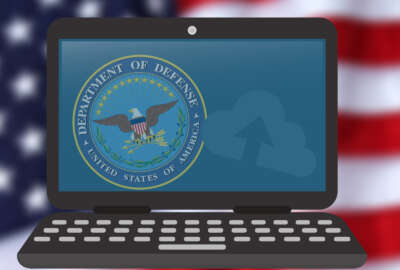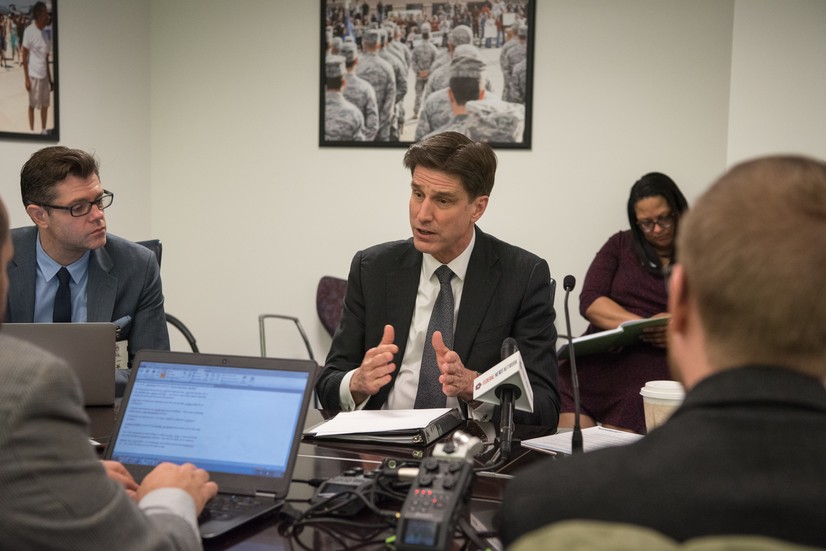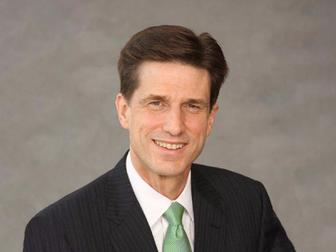
DoD CIO tries to correct JEDI facts, but may have opened new front for scrutiny
Dana Deasy, Defense Department CIO, told reporters that the Pentagon will not make an award under JEDI until Secretary Mark Esper finishes his review
Best listening experience is on Chrome, Firefox or Safari. Subscribe to Federal Drive’s daily audio interviews on Apple Podcasts or PodcastOne.
The Defense Department tried to set the record straight about its controversial cloud computing initiative called JEDI. But Dana Deasy, DoD chief information officer, may have hit upon what could be another sticking point for the Joint Enterprise Defense Infrastructure (JEDI).
And with the review by Defense Sec. Mark Esper about to begin, the future of this program continues to be in question.

During an Aug. 9 press briefing at the Pentagon, Deasy reiterated and emphasized many of the same points he and other DoD officials have made over the last 18 months. DoD will continue to have multiple clouds as it’s already spending more than $500 million a year on this technology; JEDI is not guaranteed to be worth $10 billion, and could be worth as little as $1 million over two years; and JEDI is a “pathfinder” for DoD to build an integrated infrastructure of the future.
To that end, DoD released an updated enterprise cloud fact sheet to help dispel some of what they call the myths and false narratives
Deasy, however, may have caused more confusion about why JEDI matters. As mentioned before, he said having an enterprise cloud will make it easier to get warfighter capabilities and end the current disconnected, siloed approach.
“The enterprise cloud is trying to solve the fact that today we cannot give the warfighter the data they need on the battlefield in an integrated way [or give them] updated application capability in real time,” Deasy said during the briefing, which Federal News Network obtained a recording of after being excluded from the roundtable. “We have to learn how to do that. This is not going to be the only cloud we will have across the Department of Defense. We will always have a number of clouds, but to do enterprise cloud at scale, all the way out to the disconnected warfighter…we have to learn how to integrate that. Then, over time we will bring more and more cloud providers into that.”
At the same time, Deasy said the cloud is not the real benefit of JEDI.
“It’s what you put on top of a cloud that really matters. And the fact that we will be able to build applications in a more consistent way, we will now have a methodology and a roadmap by having an enterprise cloud to build it from,” he said. “The fact that you will build applications differently means we can secure them in very different way versus the multitude of ways we build applications today in a disparate number of clouds. I don’t want that to get lost in this narrative as well.”
Apps standards needed
And it’s those comments that may create more confusion across industry and DoD.
Experts say if it’s really all about the applications for DoD, then the infrastructure doesn’t matter. It’s a matter of using good software development practices like agile or DevOps and containers that can be easily moved across infrastructure platforms and connected through application programming interfaces (APIs) to ensure data is easily shared.
In a sense, it’s not about standardizing on the platform, but getting servicemen and women and contractors to standardize on their development methodologies and techniques.
Deasy, however, continued to highlight the importance of starting with the one cloud approach and then expanding over time.
“We will have a multitude of clouds. What we are trying to describe today….think about the complexity of what it will take when we bring in the first cloud provider to set up the unclassified, the classified, the top secret, the continental United States (CONUS), OCONUS, forward base disconnected warfighter. Think about the complexity of setting that up,” he said. “We’ve got to learn how to do that with somebody. It doesn’t end there. It doesn’t mean we are going to end up with a single cloud provider. That is why I have stressed a two-year break, with a three-year extension. That was done by intentional design. As we learn how to do this, then we can start to bring in additional cloud providers.”
Again, that concept may cause more consternation in industry. As one industry source said, the reason why the fight for JEDI is so heated is because DoD’s appetite for infrastructure-as-a-service always will increase. DoD will need more compute, more storage and want to put more applications on JEDI. So being a first mover is a huge advantage for the winning company.
In many ways, Deasy confirmed the benefit of first-mover status. He said the services and agencies are under a cloud-first mandate for all new development.
“It could be JEDI or it could be a unique environment based on the requirements of the warfighter,” he said.
He added that services and agencies should not just lift-and-shift legacy systems into the cloud but determine which current applications are the best candidates.
“We will look at things such as natural breakpoints in the technology, where you are doing to upgrades on the infrastructure. We will have a methodology of how you go through and select the appropriate applications to re-port to the cloud,” he said.
Educating Esper
The future of cloud is clear for DoD, but the future of JEDI remains murky.
Deasy said his office will lead the review effort for the secretary. He didn’t say how long it will take, but the JEDI award will not happen before the review is finished.
Deasy confirmed that while there is no delay in the source selection process and technical evaluation of the two finalists — Microsoft and Amazon Web Services — he said the award likely will not happen in August like DoD had initially hoped for.
“Our job right now is to educate the secretary as to why we need a cloud. In doing so, we will make it very clear as to what it means to the warfighter and what it means to say efficiencies across the Pentagon. In having that conversation, he will have a good understanding of what are the consequences honestly if we were to make a decision not to continue with JEDI,” Deasy said. “What we will do over the next several weeks is we are actually going to bring people in to these sessions. We will bring warfighters in. We will bring the military services in. We will bring combatant command participants in, for example, U.S. Cyber Command, and we will bring technical and legal experts in as well. Part of the education is to make it real world so we will be bringing people in who can talk about real work implications and the importance of cloud. That’s how we will bring it to life for him.”
Related Stories

JEDI award delayed, DoD CIO preparing agencies for its arrival
“We will get into a deep conversation of what are the activities we are trying to solve for? What are the activities we are trying to solve for? What are the urgencies around this? How does this support the warfighter? What are the security implications? How does this help from a security standpoint? What are the securities from a commercial cloud standpoint, etc.?” he said. “Then we will have follow on sessions around how JEDI fits into a much larger overall DoD enterprise cloud strategy. We will explain to him what is the overall strategy for DoD when it comes to enterprise cloud. And where does JEDI fit into the much larger strategy?”
Deasy added another session will dive deeper into how DoD developed the JEDI program, including who was involved, considerations when developing the request for proposals and selection criteria, and other facets of the initiative.
“He needs this because he honestly has a role to weigh into the overall direction of this program and for him to be able to do that, he needs to first go through a series of deep education sessions,” he said. “At end of this process, he will obviously be at a point and in the position to weigh in with his thoughts and views on this. We will need to incorporate his thoughts and views at that time.”
Copyright © 2024 Federal News Network. All rights reserved. This website is not intended for users located within the European Economic Area.
Jason Miller is executive editor of Federal News Network and directs news coverage on the people, policy and programs of the federal government.
Follow @jmillerWFED






